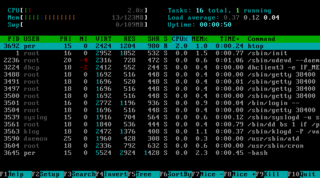Computer vision is an interdisciplinary scientific field that deals with how computers can be made to gain high-level understanding from digital images or videos. From the perspective of engineering, it seeks to automate tasks that the human visual system can do.

In computing, multitasking is the concurrent execution of multiple tasks over a certain period of time. New tasks can interrupt already started ones before they finish, instead of waiting for them to end. As a result, a computer executes segments of multiple tasks in an interleaved manner, while the tasks share common processing resources such as central processing units (CPUs) and main memory. Multitasking automatically interrupts the running program, saving its state and loading the saved state of another program and transferring control to it. This "context switch" may be initiated at fixed time intervals, or the running program may be coded to signal to the supervisory software when it can be interrupted.

An operating system (OS) is system software that manages computer hardware and software resources and provides common services for computer programs.
In computer science, real-time computing (RTC), or reactive computing describes hardware and software systems subject to a "real-time constraint", for example from event to system response. Real-time programs must guarantee response within specified time constraints, often referred to as "deadlines". The correctness of these types of systems depends on their temporal aspects as well as their functional aspects. Real-time responses are often understood to be in the order of milliseconds, and sometimes microseconds. A system not specified as operating in real time cannot usually guarantee a response within any timeframe, although typical or expected response times may be given.

Computer-aided design (CAD) is the use of computers to aid in the creation, modification, analysis, or optimization of a design. CAD software is used to increase the productivity of the designer, improve the quality of design, improve communications through documentation, and to create a database for manufacturing. CAD output is often in the form of electronic files for print, machining, or other manufacturing operations. The term CADD is also used.

In computing, a process is the instance of a computer program that is being executed. It contains the program code and its activity. Depending on the operating system (OS), a process may be made up of multiple threads of execution that execute instructions concurrently.
Supervisory Control and Data Acquisition (SCADA) is a control system architecture that uses computers, networked data communications and graphical user interfaces for high-level process supervisory management, but uses other peripheral devices such as programmable logic controller (PLC) and discrete PID controllers to interface with the process plant or machinery.
The use of SCADA has been also considered for management and operations of project-driven-process in construction.

Data acquisition is the process of sampling signals that measure real world physical conditions and converting the resulting samples into digital numeric values that can be manipulated by a computer. Data acquisition systems, abbreviated by the acronyms DAS or DAQ, typically convert analog waveforms into digital values for processing. The components of data acquisition systems include:
Classification is a process related to categorization, the process in which ideas and objects are recognized, differentiated, and understood.

A flowchart is a type of diagram that represents an algorithm, workflow or process. Flowchart can also be define as a diagramatic representation of an algorithm.
In computing, an interface is a shared boundary across which two or more separate components of a computer system exchange information. The exchange can be between software, computer hardware, peripheral devices, humans, and combinations of these. Some computer hardware devices, such as a touchscreen, can both send and receive data through the interface, while others such as a mouse or microphone may only provide an interface to send data to a given system.
The Bachelor of Computer Science or Bachelor of Science in Computer Science is a type of bachelor's degree, usually awarded after three or four years of collegiate study in computer science, but possibly awarded in fewer years depending on factors such as an institution's course requirements and academic calendar. In some cases it can be awarded in five years. In general, computer science degree programs emphasize the mathematical and theoretical foundations of computing.
Industrial technology is the use of engineering and manufacturing technology to make production faster, simpler and more efficient.The industrial technology field employs creative and technically proficient individuals who can help a company achieve efficient and profitable productivity.

Not to be confused with computer engineering.
The following outline is provided as an overview of and topical guide to automation:
Reverse engineering, also called back engineering, is the process by which a man-made object is deconstructed to reveal its designs, architecture, or to extract knowledge from the object; similar to scientific research, the only difference being that scientific research is about a natural phenomenon.
Industrial engineering is an inter-disciplinary profession that is concerned with the optimization of complex processes, systems, or organizations by developing, improving and implementing integrated systems of people, money, knowledge, information, equipment, energy and materials.
This is a glossary of terms relating to computer hardware – physical computer hardware, architectural issues, and peripherals.











